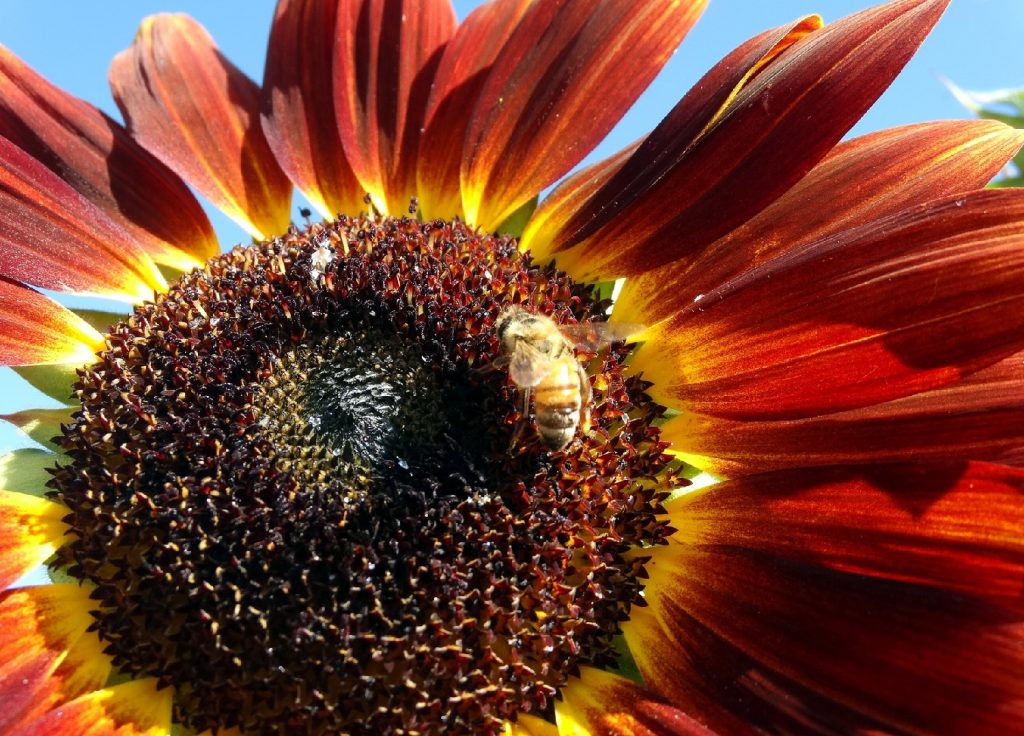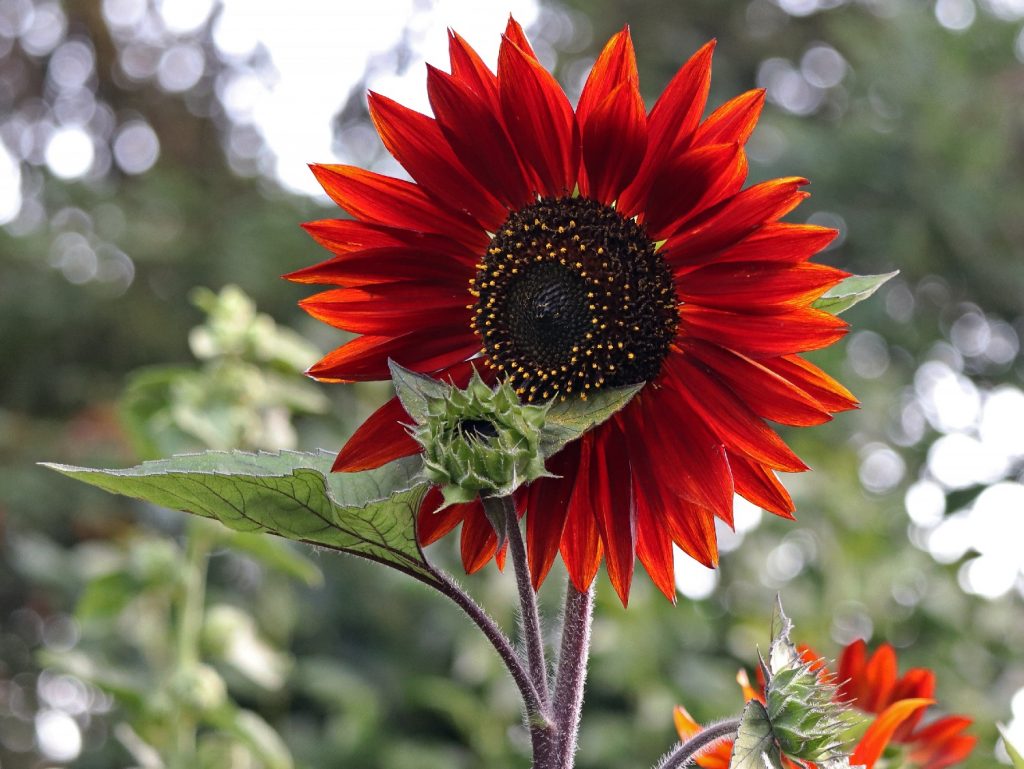
We’re here to help! Wild Yards is a completely free website that is 100% dedicated to helping you create a wildlife-friendly, sustainable yard. Read more
WildYards is reader-supported. When you buy a product through a link on our site, we may earn a comission. Every product is independently selected by our (obsessive) editors and our reviews are unbiased and objective. Read more about our mission or our privacy policy.
A festive take on an old classic, red sunflowers are a fantastic way to add a splash of color to your backyard. These gorgeous blooms can help you dress up your flower garden without making it too pretentious. And they combine beauty with functionality by protecting vegetable gardens and other valuable plants from the sun’s harsh rays. But, are red sunflowers easy to grow?
Like yellow sunflowers, red sunflowers are incredibly simple to grow. These annual blooms are among the easiest plants to start from seeds. They mature rapidly, often within just three months, and eventually produce seeds that squirrels, birds, and other wildlife enjoy foraging on.
What’s the best way to grow red sunflowers from seeds?
To get your red sunflowers growing, we recommend starting them indoors in small seed pots. This prevents the young plants from being foraged on by hungry deer. Start your seedlings in late spring, when the outdoor temperature is at least 60 degrees Fahrenheit. And keep them on a sunny windowsill, where they’ll stay warm.
To start, fill peat seed pots or small paper cups with a potting mixture containing 50% potting soil, 30% coco peat, and 10% compost. This mix provides the seeds with a steady supply of nutrients while keeping the soil moist, but well-drained.
Once the pots are filled, make a small hole about an inch deep, and plant two to three seeds. Cover them and gently pack the soil around them. Sunflower seeds germinate in 10 to 14 days. After the seeds have sprouted, identify the strongest seedling, and uproot the weaker ones so they won’t inhibit the larger sunflower’s growth.
Keeping the soil damp is crucial to your red sunflower seedlings’ survival. These plants require a lot of water to grow. Water them well and regularly, but be careful not to drown them, as too much water will prevent nutrient and oxygen uptake.
When can you transplant your red sunflowers?
The best time to transplant your red sunflower seedlings is after they’ve reached six inches tall and after they’ve developed true leaves. These leaves are bigger than a seedling’s foliage and are shaped like mature leaves.
To transplant your red sunflowers, use a small hand trowel to dig a hole 8 to 10 inches deep. Loosen the young sunflower from its pot as gently as possible, then position it in the hole. You want the root collar to be level with the surrounding ground, so remove or backfill dirt as necessary. Once positioned, gently scoop the loose dirt back into the hole, tamping it down to remove air pockets.
Be sure to plant your sunflowers in a location that receives at least six hours of sunlight every day. It’s also important to ensure the soil you plant your red sunflowers in is loamy and well-drained with a good amount of organic matter for added nutrition.
Can you start red sunflowers right in the ground?
It’s best to start your seeds inside to protect them as they sprout. Animals may eat them or root around in the moist soil around them looking for bugs. Either way, the young plants suffer. However, you can start your seeds outside if you prefer. Just be sure to plant your red sunflower seeds after the last frost of the season. Cold temperatures will kill young sunflowers.
Choose a sunny location with well-draining soil, and plant your sunflower seeds an inch deep with two to three seeds per hole. Once they sprout, thin them out, leaving the strongest seedlings to grow. Keep 18 to 28 inches between plants, and don’t forget to water them regularly so the soil doesn’t dry out.
When do red sunflowers bloom?
When your red sunflowers bloom depends on their variety. But, in general, red sunflowers bloom three to four months after germination. This means you’ll start seeing your red sunflowers bud out in the midsummer.
Sunflower blooms last for around 20 days. This gives hoverflies, beetles, butterflies, and hummingbirds ample opportunity to collect nectar. Unfortunately, red sunflowers typically do not produce pollen. And, because they’re red, they’re harder (though not impossible) for bees to see, so they’re not the best sunflowers for attracting bees. However, many pollinators still love to visit red sunflowers because their large open flower heads radiate heat keeping them warm as they forage for food.
Red sunflowers are annuals, meaning the plants die every year and must be started again from seeds. While sunflowers are self-seeding in theory, their seeds often fall prey to hungry foragers, including squirrels, birds, chipmunks, and deer. If you want to grow more red sunflowers next season, you’ll need to collect some seeds before animals eat them all.
Where’s the best place to plant your red sunflowers?
As we mentioned earlier, you want to plant your sunflowers where they’ll receive plenty of sunlight. But if you have a vegetable patch, you can use your red sunflowers to your advantage by growing them along the sunniest edge of your garden.
This strategy has two main advantages. One is that it helps keep the vegetable plants in the shade. While most vegetables like lots of sunlight, too much can slow their growth reducing crop yield.
The second benefit to growing red sunflowers near your vegetable garden is that it helps support pollination. High-flying insects will be drawn to your towering red sunflowers, and will soon notice the flowering vegetable plants nearby, improving the pollination rates of your vegetables and increasing crop production.
If you don’t want to use your sunflowers to help your vegetable patch, try planting them on the east side of a structure, like a shed or a garage, instead. This helps trap the heat of the rising sun, keeping the plants nice and warm.

Do red sunflowers attract other wildlife to your yard?
Sunflowers are a big hit with wildlife. In addition to the aforementioned pollinators, red sunflowers will help draw more deer, squirrels, and chipmunks to your yard. They will also attract seed-eating birds, including (but not limited to) woodpeckers, jays, chickadees, goldfinches, sparrows, and nuthatches.
If you want to use your red sunflowers for the sole purpose of bringing more wildlife to your backyard, be sure to plant them away from your garden rather than close by. This will allow animals to enjoy your sunflowers’ seeds without sending them an open invitation to your vegetable patch.
If you want to use your red sunflowers purely for their vegetable garden benefits, be sure to wildlife-proof your garden with deer repellent and bird-scare tape. That way, pollinators will still be able to visit them, but foragers will not.
How should you care for your red sunflowers as they grow?
Sunflowers are easy to care for. These low-maintenance blooms are ideal for outdoor enthusiasts who want a pretty backyard but don’t have the time to pamper their ornamentals. Just make sure you meet all of the red sunflower’s growing requirements: plant your sunflowers in neutral to slightly acidic sandy to loamy soil, in a place where they receive six hours of sunlight daily. Water them thoroughly once or twice a week, every second or third day during dry periods. This is the best way to start, but there are a few other things you can do to keep these flowers happy.
Sunflowers grow like weeds, so they perform well even when they’re kept near other plants. But many actual weeds have shallow root systems, like sunflowers, and will compete for the same nutrients. Be sure to keep your sunflower patch well-weeded to maximize flower production and plant size.
And while there’s no need to fertilize your sunflowers, you can give them a leg up by feeding them once a month. Sunflowers love potassium, potash, and nitrogen, so give them a fertilizer with adequate amounts of these minerals. Fertilizing red sunflowers helps support healthy foliage and flower production.

How should you care for mature red sunflower plants?
Sunflowers are tall plants, and once they bloom, they become top-heavy. If the blooms are especially weighty, they may pull the tip of the stalk all the way down to the ground. So for best results, grow your sunflowers along a trellis or a structure that has some lattice nailed onto it, so you can tie your mature red sunflowers up if they need assistance.
It’s also important to examine your sunflower leaves regularly. Leaves provide a clue to the sunflower’s overall health. Wilted leaves or leaves that have become brown and crunchy are a sign that your sunflowers aren’t getting enough water. Meanwhile, yellow, black, and brown discolorations are signs of insect infestations and disease. Familiarize yourself with your red sunflowers’ leaves and treat problems quickly to keep your plants healthy.
Do red sunflowers live up to the hype?
Red sunflowers are every bit as easy to grow as yellow sunflowers. These beautiful blooms offer a welcome change of pace to classic sunflowers and look just as pretty planted amongst traditional cultivars as they do when grown by themselves.
Not only are these flowers handsome, but they can also improve pollination rates in your garden and keep your other plants in the shade, too. While it can be tough to prevent animals from eating them all, their seeds can be collected and used to grow new flowers over and over again, making red sunflowers well worth their initial investment.
